#Via dei Fori Imperiali
Text
Giornata di azione mondiale per Gaza - Roma, 13 Gennaio 2024
Il 13 Gennaio, a 100 giorni dall’inizio del conflitto sulla Striscia di Gaza, si è svolta la “Giornata di azione mondiale per Gaza“, coinvolgendo 121 città in 45 paesi tra cortei e manifestazioni. Le organizzazioni coinvolte hanno affermato in una dichiarazione che la Giornata globale mira a “intensificare la pressione internazionale per un cessate il fuoco permanente, porre fine all’occupazione…

View On WordPress
#Colosseo#gaza#israel#israele#palestina#palestine#palestine tv#report#Reportage#Roma#servizio tg#striscia di gaza#telegiornale#Via dei Fori Imperiali
0 notes
Text

Rome, via dei Fori Imperiali, une famille américaine en vacances, 1950. Source Memorie di Roma.
99 notes
·
View notes
Text
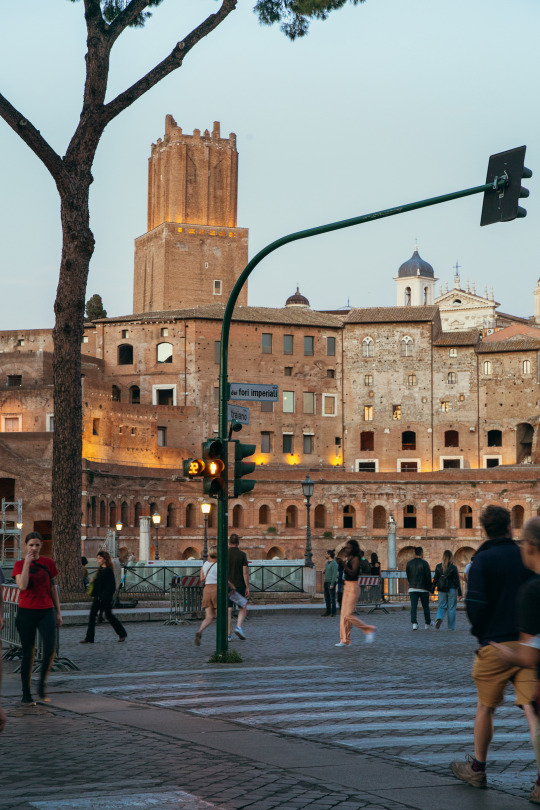
Foro di Traiano, Via dei Fori Imperiali, Roma.
Forum of Trajan, Via dei Fori Imperiali, Rome.
#architecture#photography#travel#roma#rome#ancient rome#roma antica#centro#centro storico#storia#history#trajan#Traiano#Italy#Italia#Europe#urban street photography#street photography#urban#ancient history#foro#fori#forum#imperial#empire#red light#medieval architecture
31 notes
·
View notes
Text
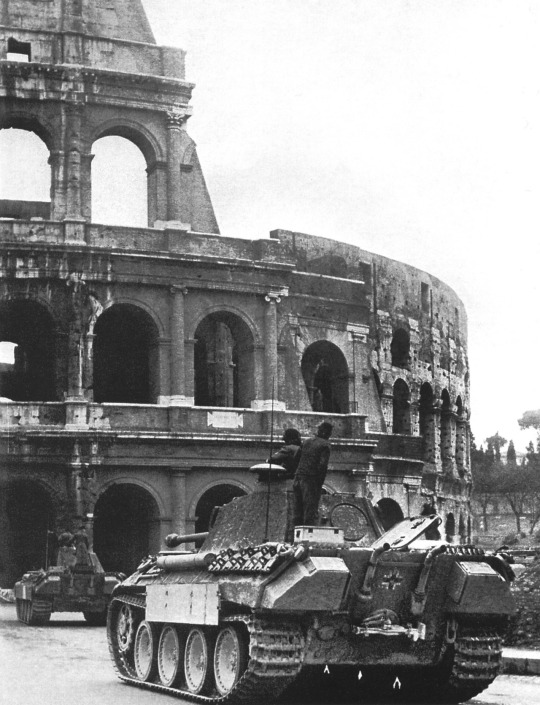
A column of Panthers from I.Abteilung-Panzer-Regiment 4 approaching the Colosseum on the Via dei Fori Imperiali in February 1944
12 notes
·
View notes
Note
Fun fact on the knife block: it's Italian. And we actually LOVE Caesar, he's one of our national heroes, enough that to this day people are still leaving flowers on his altar in the Temple of Caesar in Rome and in front of his statue in Via dei Fori Imperiali (a street that passes by much of Rome's archeological patrimony)... But we still have the Romans' morbid sense of humor that prompted Caesar's own soldiers to warn the citizens of Rome that the bald womanizer was back in Rome during the triumphal parade (and that one was the lightest of the jokes that Caesar's troops were slinging at him during the Triumphs), so we make knife blocks and pencil holders that look like his bust with the knives or pencils inserted as if he was stabbed.
So you're saying you've come to meme Caesar, not to praise him.
21 notes
·
View notes
Text

Antinoüs, head of the remains of a statue found during excavations conducted in the 1930's, to build the Via dei Fori Imperiali.
Now exhibited in the Centrale Montemartini, Via Ostiense, Roma.
One of the youngest-looking portrait of Antinoüs.
Setting : ► https://www.tumblr.com/arbandes/741696868914003968/antino%C3%BCs-and-his-contemporary-friends-in-the
6 notes
·
View notes
Text

La statua di Giulio Cesare lungo via dei Fori Imperiali ❤️🇮🇹
•📸 Foto di Roma ad Hoc
2 notes
·
View notes
Text
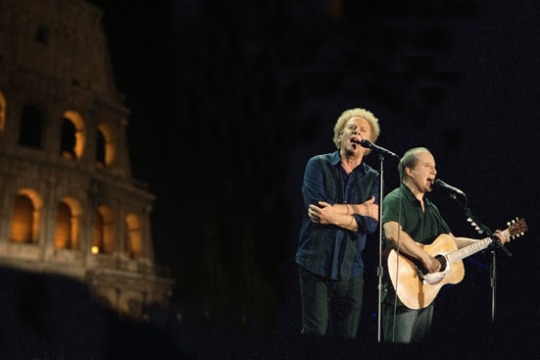
Il 31luglio 2004 concerto in via dei Fori Imperiali di fronte al Colosseo di Simon e Garfunkel: tappa di un tour in 28 città nel mondo. La reunion, con 600 mila spettatori, sarà immortalata nel cd e nel dvd Old Friends: Live On Stage. Ospiti della serata gli Everly Brothers.
10 notes
·
View notes
Text

Politician, tactician, orator and an ambitious man. Gaius Julius Caesar is without doubt the most famous man of Roman history and needs no introductions.
Born in the year 100 BC, Caesar was a member of the patrician family gens Julia, who according to legends descended from Aeneas´ son Julus (Ascanius). About Aeneas, who claimed to be the son of Venus/Aphrodite we briefly talked about in our previous post, feel free to check it out! While the family was ancient, at that time it had no great political influence.
Alongside Gnaeus Pompeius Magnus and Marcus Licinius Crassus they represented the First Triumvirate, which was a political alliance whose purpose was to keep the three in power. Caesar´s tactical prowess was most famously shown in the Gallic Wars and the Civil war.
Caesar laid the foundations for the Roman Republic to turn into an Empire, but he himself never became an Emperor. He was assassinated on the 15th of March, also known as Ides of March.
In Gladiator Chronicles we see him depicted in the various beautiful backgrounds in the form of statues and art. Makes us wonder how history went in this world…



Statue of Julius Caesar, Via dei Fori Imperiali, Rome; Statue in the background of GC Caesar palace and a hologram in Flavius´ ludus
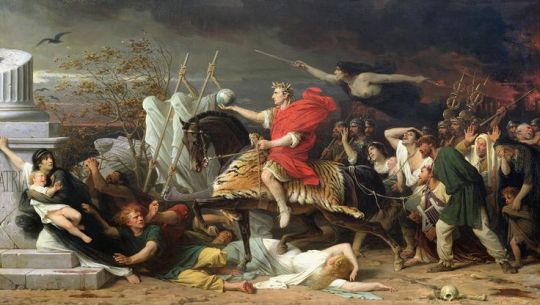

Caesar crossing the Rubicon by Adolphe Yvon; 1875; Painting in the background of Labelle´s office
#romance club#gladiator chronicles#gc appreciation week#rcgcaw#rc appreciation weeks#rc gladiator chronicles#lore
26 notes
·
View notes
Text
Day 2 in Rome
Our second day in Rome went, overall, better than our first. It was also a very full day, as the in-laws were flying home the next day and wanted to squeeze a lot in.
There was a transit strike that day, but we fortunately knew that ahead of time. We got up early and walked to the Pantheon, arriving about 10 minutes after they had opened... only to find lines even longer than they were the previous afternoon. I nearly cried.
But there were 3 lines, with no guidance as to what each was for, so I went up to ask the employees near the front of the Pantheon. It turned out that one line was to buy tickets with cash, but if you did that, you would have to wait in a second line to enter. The third line was for paying by credit card, and if you did that you would not have to wait in a second line to enter. We all agreed that sounded better. What wasn't clear was whether we needed to buy the ticket online in advance, or if you could pay with the credit card at the front of the line, so I figured we should get them online to be safe. There didn't seem to be a way to order a ticket for entry so I reserved us the audioguide, which was 10euro each. Some of the others went to get a coffee granita while waiting. I stood in line. It took about 45 minutes, but we did get in--though it also turned out we had not paid for entry and had to do that separately at the entrance anyway. But the audioguide did actually contain (in addition to rather more Catholic propaganda than I was in the mood for) some information that was new to me. We stayed in there for an hour, and I still felt moved by it, but I knew we wouldn't go back in on this trip. I wonder if they will ever improve the logistics. Why don't they just sell timed tickets like most museums do?
Afterwards, I got a coffee granita with whipped cream. Then we visited Bernini's little elephant statue and went into the church in that piazza (Santa Maria Sopra Minerva), which was actually built over a temple to Isis, not Minerva. The outside is plain, but the inside is very ornate.
It was getting very hot, so our next activity was a gloriously air-conditioned museum with an exhibition of hyperrealism: mainly sculptures of humans, though sometimes not the whole body and sometimes on a different size scale. It was pretty interesting. My favorite was a series of self-portrait works by an artist named Valter Adam Casotto, in which he made enlarged but extremely realistic sculptures of various parts of his own body (lips and chin; elbow; etc.) and then "tattooed" them with his childhood drawings.
After that, we ate in the museum cafe, which was slow, but I liked my food. Then we had a very hot walk down via dei Fori Imperiali past the Roman Forum and toward the Coliseum. After that we walked up the hill through a park. It was unbearably hot by then, but we stumbled upon a church and went in and then discovered they had excavations underneath it of previous structures, so we got to go down below ground where it was considerably cooler. That was lovely!
After that we went to get an aperitivo (I had a frozen strawberry daiquiri) and snacks before a brief shower and rest at the hotel, and then out to dinner. I had a nice pizza, followed by a gelato I regretted as I was already too full and the gelato wasn't that great.
3 notes
·
View notes
Text
2nd June: Italy's National Day
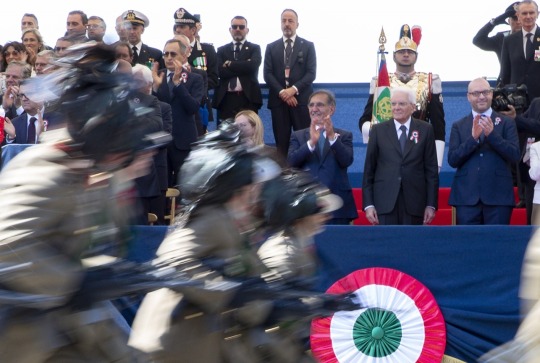

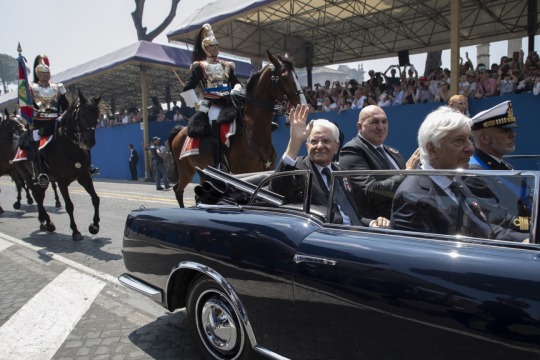

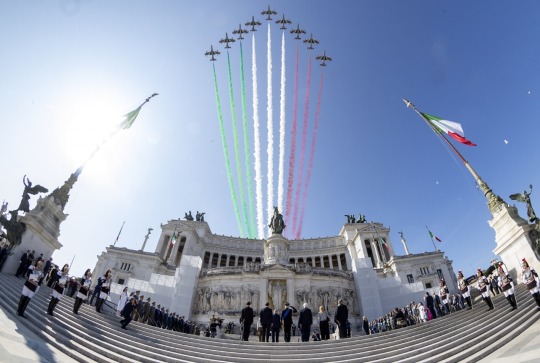
Military parade along Via dei Fori Imperiali and tribute to the Unknown Soldier at the Altare della Patria in Rome. Source: www.quirinale.it
Buona Festa della Repubblica a tutti gli italiani!!! 😃😃
#have a nice day!#2 giugno#festa della repubblica#italy's national day#2nd june#military parade#rome#president of the italian republic#sergio mattarella#quirinale#frecce tricolori#italy
4 notes
·
View notes
Text
Fori Imperiali: Sangiuliano presenta il progetto di riqualificazione dell'area archeologica
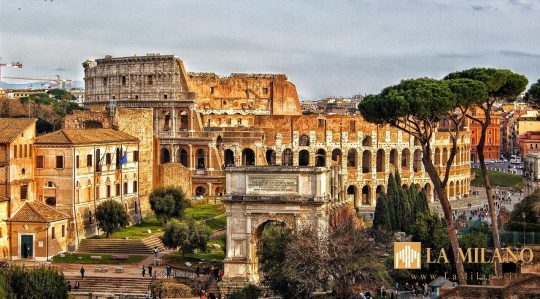
Fori Imperiali: Sangiuliano presenta il progetto di riqualificazione dell'area archeologica.
Il panorama storico e culturale di Roma si prepara a vivere un nuovo capitolo con la riqualificazione dei Fori Imperiali. L'annuncio è avvenuto ieri, martedì 2 aprile, durante un evento svoltosi ai Mercati di Traiano - Museo dei Fori Imperiali, ed organizzato dal Ministro della Cultura, Gennaro Sangiuliano, in collaborazione con il Sindaco di Roma, Roberto Gualtieri, e il Sovrintendente Capitolino Claudio Parisi Presicce.
L'incontro ha visto la presentazione della graduatoria provvisoria del bando internazionale del progetto "La Nuova Passeggiata Archeologica", che mira a trasformare l'Area dei Fori Imperiali in un polo culturale e turistico di livello mondiale. Indetto lo scorso ottobre da Roma Capitale - Sovrintendenza Capitolina ai Beni Culturali, ha attratto l'attenzione di numerosi studi di architettura e urbanistica, con 23 proposte progettuali pervenute.
A vincere è stato lo studio Labics di Maria Claudia Clemente e Francesco Isidori. Il loro concept, accuratamente valutato dalla Commissione giudicatrice presieduta dall'architetto portoghese Joao Luis Carrillho da Graça, ha dimostrato di rispondere in modo completo ed esaustivo alle richieste del bando.
Il progetto Labics propone un approccio integrato e dettagliato, articolando le soluzioni nei diversi lotti di intervento con una particolare attenzione ai dettagli. La proposta si distingue per la chiara identificazione delle relazioni trasversali tra via dei Fori Imperiali e le aree archeologiche adiacenti, garantendo spazi fruibili e accessibili sia ai pedoni che ai ciclisti. Particolarmente convincenti sono state considerate le soluzioni proposte per la sistemazione della scarpata sottostante via Nicola Salvi e il progetto del centro servizi su via del Tempio della Pace.
L'obiettivo è creare un grande anello pedonale che colleghi l'intera area archeologica centrale della città, integrando le bellezze storiche con la vita quotidiana dei rioni circostanti. La Nuova Passeggiata Archeologica sarà caratterizzata da spazi pedonali, aree verdi, balconate, percorsi sopraelevati e percorsi ciclo-pedonali, con un investimento stimato di euro 18.800.000,00 al netto di I.V.A.
"Tra i primi impegni da Ministro c’è stata una lunga interlocuzione con il Sindaco di Roma per la riqualificazione dell’area dei Fori Imperiali che ha portato alla sottoscrizione di un protocollo frutto del lavoro del Tavolo tecnico congiunto per la valutazione del progetto sull’area dei Fori a cui erano presenti, per il Ministero della Cultura, il Direttore del Parco Archeologico del Colosseo, Alfonsina Russo e la Soprintendente Speciale di Roma, Daniela Porro - ha spiegato il Ministro della Cultura Sangiuliano, sottolineando l'importanza di preservare e valorizzare il patrimonio storico di Roma -. Nel protocollo, firmato da me e dal Sindaco Roberto Gualtieri, sono stati fissati alcuni punti cardine e imprescindibili per l’intervento che si andrà a realizzare".
Tra quelli citati, "il rispetto del vincolo storico di via del Fori Imperiali, già concepito in epoca napoleonica con i progetti affidati prima a Giuseppe Valadier e Giuseppe Camporesi e poi all’architetto francese Louis-Martin Berthault, il primo a proporre un asse lineare tra Campidoglio e Colosseo, con un progetto particolarmente interessante anche per la sua capacità di ricomporre gli scavi archeologici in un disegno unitario".
Il progetto vincitore sarà ora sottoposto a verifiche di legge e successivamente sarà avviata la fase di perfezionamento del progetto di fattibilità tecnico-economica. Si prevede che i lavori possano iniziare entro settembre, se tutte le tempistiche saranno rispettate.
La Nuova Passeggiata Archeologica rappresenta solo il primo tassello di un progetto più ampio di trasformazione del Centro Archeologico Monumentale di Roma (CArMe), con un investimento complessivo di 282 milioni di euro nel triennio 2025-2027.
...
#notizie #news #breakingnews #cronaca #politica #eventi #sport #moda
Read the full article
0 notes
Text
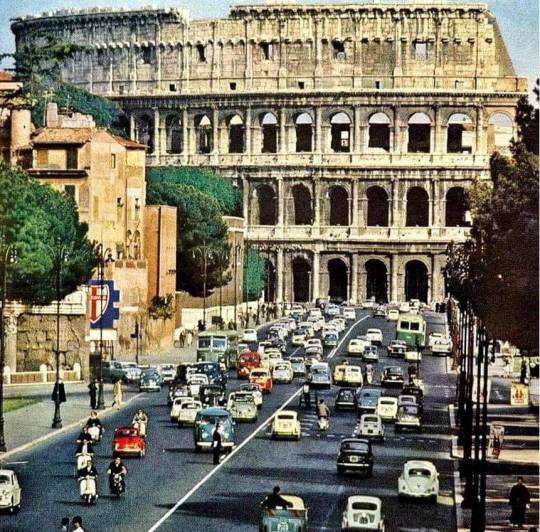
Rome, Via dei Fori Imperiali, c. 1970 - Source Memorie di Roma.
60 notes
·
View notes
Text
THINGS TO KNOW BEFORE TRAVELING TO ROME- UNWRITTEN DO’S AND DON’TS

Every corner of the globe has its unique traditions and customs intricately woven into the fabric of a nation’s culture and it is important to be respectful towards them. There are also unspoken norms that you should be aware of, especially if you’re new to the area.
More info Travel blog
Certainly, Rome is no exception to this rule. A common saying is to “do as the Romans do,” so we have some valuable tips to help you navigate through Rome during your vacation.
The Do’s
1. Dress Modestly for Religious Sites
Keep in mind that when you visit Rome, you’ll be exploring important places, including churches. It is home to numerous religious sites where you need to follow a dress code before going inside. Modest clothing is a mandate while visiting these sites. You must keep a scarf or shawl to cover your shoulders whenever needed.
2. Follow the Roman meal timetable
If you’re accustomed to having lunch at noon and dinner at 6 p.m., you might need to adjust your schedule a bit when in Rome. Lunch is typically served around 1:30 p.m., and dinner is served around 8 p.m. While a few restaurants offer all-day dining, these are mainly intended for tourists. Genuine Roman restaurants usually close during the afternoon. If you’re waiting for your dinner reservations, you might want to explore the city’s aperitivo scene, a lively pre-dinner happy hour that serves light cocktails and snacks.
3. Greet Shopkeepers and Restaurant Staff
When entering a shop or dining establishment, it’s customary to greet the staff with a warm “buongiorno” (good morning) or “buonasera” (good evening). This simple act of politeness goes a long way in establishing a positive interaction while you are traveling to Rome.
4. Carry a water bottle with you
The tap water in Rome is safe for drinking. An important tip for your Rome visit is to carry a reusable water bottle at all times. Buying bottled water can be costly, so if you must purchase water, we recommend opting for larger one-liter bottles from convenience stores. Tourist-targeted small water bottles can cost around 2 € each.
5. Learn basic Italian words
Learning basic greetings in a new city is helpful. Before traveling to Rome-, get familiar with simple Italian phrases. Start with:
Buon Giorno = Good morning/Good afternoon
Buona sera = Good evening
Ciao = Hello/Goodbye
Arrivederci = Goodbye
Grazie = Thank you
Parla Inglese? = Do you speak English?
6. Enjoy Your Espresso Standing
At neighborhood cafés, it’s usual to savor your espresso while standing at the counter. This not only provides a fast and genuine encounter but is also frequently more economical than sitting. If you sit at a table for coffee in Italy, the cost might increase by two or three times to cover serving it there. So, when you order coffee, pay at the counter, get the receipt, give it to the barista, take your coffee, and enjoy it standing at the bar.
The Don’ts
1. Don’t travel afar alone
Unless you’re accompanied by knowledgeable locals or seasoned guides, it’s wise to avoid straying from the well-trodden paths frequented by both residents and tourists. Whether it’s day or night, like in any city worldwide, wandering into less desirable areas might inadvertently put you at risk.
2. Don’t Overlook the “Coperto” Charge
In many restaurants, you might notice a “coperto” charge on the bill. This is a cover charge that includes the cost of bread and table service. It’s a customary practice, so be prepared for it.
3. Do not take photos of gladiators just like that
Avoid taking casual photos of gladiators, legionaries, and centurions. As you walk along Via dei Fori Imperiali from Piazza Venezia to the Colosseum, near the Palatine and Roman Forum entrances, around the Colosseum, and frequently near Castel Sant’Angelo, you’ll encounter well-known figures dressed as Roman gladiators in historical attire. It’s tempting to capture these moments for a lasting memory of your remarkable journey. However, to prevent any unpleasant surprises, make sure to agree upon the “fee” beforehand.
4. Don’t eat and stand
In Italy, meal times hold special significance, and Italians are known for savoring extended lunches and dinners. Even though street food has gained popularity throughout the city, the custom remains that you find a place to sit at a casual eatery, stand at the bar while you dine, or opt for takeout and find a bench in a nearby park. Unlike in some places, Italians don’t typically eat or drink while walking on the streets, and it’s best if you follow suit. It’s worth noting that this rule doesn’t apply to gelato.
5. Never Order Cappuccino After 11 AM
In Italy, there’s a cultural tradition tied to the consumption of milk-based drinks, particularly cappuccino. According to this belief, cappuccinos are considered a morning indulgence, best suited to kick-start your day. Here, it’s not common to order a cappuccino in the afternoon or evening. Locals prefer other drinks during these times, as they value enjoying different beverages at appropriate moments, following their culinary customs and daily routines.
6. Avoid Eating Near Tourist Hotspots
When at tourist attractions, beware of nearby restaurants. These are usually tourist traps. They may seem convenient but often charge more and lack authentic food. Opt for local trattorias a bit farther away, where you’ll find true flavors and traditional dishes. By venturing off the beaten path, you’ll enjoy affordable meals and a genuine taste of Rome’s culinary culture.
https://www.centrostorico21.com
0 notes
Text
Domani il grande giorno della Acea Run Rome The Marathon
Alle 8.30 il via della Acea Run Rome The Marathon, il grande giorno è arrivato, la gara dei record in Italia partirà dai Fori Imperiali.
Quasi 19mila gli atleti che scriveranno il proprio nome sulle strade di Roma, tra sampietrini, monumenti, il Lungotevere e quell’aria magica da “Vacanze Romane” tanto decantata da pellicole divenute un cult. Tutti insieme, i maratoneti della Città Eterna…
View On WordPress
0 notes
Text
Nella prima delle cinque "domeniche ecologiche" previste dal calendario 2023-2024, la Giunta capitolina ha disposto il blocco del traffico per tutti i veicoli a motore nella nuova Zona a Traffico Limitato (Ztl) "Fascia Verde". La giornata ecologica, stabilita in aderenza alle normative europee, nazionali, regionali e comunali per la riduzione dell'inquinamento atmosferico, si terrà domani, 19 novembre.
La Giunta, attraverso l'ordinanza del sindaco Roberto Gualtieri n.121 del 16 novembre 2023, ha stabilito gli orari di blocco della circolazione, dalle 7:30 alle 12:30 e dalle 16:30 alle 20:30. Le altre date delle "domeniche ecologiche" sono fissate per il 3 dicembre 2023, il 14 gennaio, il 25 febbraio e il 24 marzo 2024.
Restrizioni e Deroghe al Blocco del Traffico
Durante il blocco del traffico, i veicoli a motore termico, compresi quelli Euro 6, saranno proibiti all'interno della Fascia Verde del Piano generale del traffico urbano. Tuttavia, saranno esenti dall'obbligo di fermo auto elettriche, taxi e Ncc.
Ci sono deroghe previste per veicoli specifici come quelli elettrici, ibridi, alimentati a metano o GPL, bi-fuel (ad esempio benzina/GPL o benzina/metano) omologati in classe Euro 3 e successive, ciclomotori e motocicli con specifiche caratteristiche di classe Euro.
Per conoscere tutte le categorie di veicoli esentati dal blocco del traffico è possibile consultare l'ordinanza sul portale di Roma Capitale.
Utilizzo dei Riscaldamenti
Parallelamente al blocco del traffico, permane l'Ordinanza sindacale n.114 del 31 ottobre 2023 che regolamenta l'utilizzo degli impianti di riscaldamento domestico. La disposizione limita l'uso degli impianti a un massimo di 11 ore giornaliere, mantenendo una temperatura non superiore a 19°C (+2°C di tolleranza) sull'intero territorio comunale.
Dichiarazioni dell'Assessora all'Ambiente
Sabrina Alfonsi, assessora all'Agricoltura, Ambiente e Ciclo dei rifiuti di Roma Capitale, afferma: "Le domeniche ecologiche sono una rilevante occasione di sensibilizzazione sulla sostenibilità ambientale e sull'importanza di ridurre le emissioni inquinanti. Sono azioni cruciali per la nostra salute e per rispettare gli obiettivi di neutralità climatica stabiliti per il 2050 dalle direttive europee".
Alfonsi continua: "Vogliamo coinvolgere la cittadinanza in queste giornate di stop al traffico, trasformandole in momenti di riappropriazione collettiva della città, di socialità e divertimento per tutte le fasce d'età. In occasione della prima domenica ecologica, abbiamo organizzato un grande evento cittadino con spettacoli musicali, danze, performance di street band, esibizioni di band studentesche, intrattenimento per bambini e laboratori di divulgazione ambientale, che si terranno dalle 10:00 alle 19:00 in via dei Fori Imperiali".
Roma si prepara così alla prima domenica ecologica, promuovendo non solo l'iniziativa ambientale ma anche una giornata di intrattenimento e sensibilizzazione sulla sostenibilità per tutti i cittadini.
0 notes